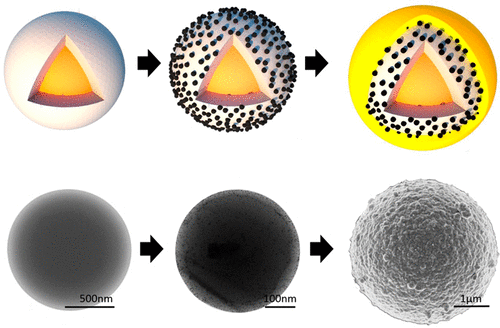Our official English website, www.x-mol.net, welcomes your feedback! (Note: you will need to create a separate account there.)
Adsorption of Catalytic Nanoparticles onto Polymer Substrates for Controlled Deposition of Microcapsule Metal Shells
Langmuir ( IF 3.9 ) Pub Date : 2018-01-16 00:00:00 , DOI: 10.1021/acs.langmuir.7b02874 James P. Hitchcock 1 , Alison L. Tasker 2 , Kirsty Stark 2 , Andrew Leeson 2 , Elaine A. Baxter 3 , Simon Biggs 2 , Olivier J. Cayre 2
Langmuir ( IF 3.9 ) Pub Date : 2018-01-16 00:00:00 , DOI: 10.1021/acs.langmuir.7b02874 James P. Hitchcock 1 , Alison L. Tasker 2 , Kirsty Stark 2 , Andrew Leeson 2 , Elaine A. Baxter 3 , Simon Biggs 2 , Olivier J. Cayre 2
Affiliation

|
Efficient encapsulation of small chemical molecules and their controlled targeted delivery provides a very important challenge to be overcome for a wide range of industrial applications. Typically rapid diffusion of these actives across capsule walls has so far prevented the development of a versatile widely applicable solution. In an earlier publication, we have shown that thin metal shells are able to permanently retain small molecules. The critical step in the microcapsule synthesis is the formation of a strongly adsorbed, dense monolayer of catalytic nanoparticles on the surface as this affects the secondary metal film quality. Control over Pt-nanoparticle adsorption density and a clear understanding of Pt-nanoparticle adsorption kinetics is therefore paramount. Maximising the density of heterogeneous catalysts on surfaces is generally of interest to a broad range of applications. In this work, transmission electron microscopy (TEM) and quartz crystal microbalance (QCM) are used to demonstrate that the concentration of nanoparticle polymer stabilizer used during particle synthesis and nanoparticle suspension concentration can be used to control nanoparticle surface adsorption density. We demonstrate that excess polymer, which is often used in nanoparticle synthesis but rarely discussed as an important parameter in the literature, can compete with and thus drastically affect the adsorption of the Pt-nanoparticles.
中文翻译:

催化纳米粒子在聚合物基质上的吸附,以控制微胶囊金属壳的沉积
小化学分子的有效封装及其受控的目标传递提出了一个非常重要的挑战,需要在广泛的工业应用中加以克服。通常,到目前为止,这些活性物质在胶囊壁上的快速扩散阻止了通用性广泛应用的解决方案的开发。在较早的出版物中,我们已经表明,薄金属壳能够永久保留小分子。微胶囊合成中的关键步骤是在表面上形成强烈吸附的致密催化纳米颗粒单层,因为这会影响二级金属膜的质量。因此,对Pt纳米颗粒吸附密度的控制和对Pt纳米颗粒吸附动力学的清晰理解至关重要。使表面上的非均相催化剂的密度最大化通常是广泛应用的兴趣所在。在这项工作中,使用透射电子显微镜(TEM)和石英晶体微量天平(QCM)来证明在颗粒合成过程中使用的纳米颗粒聚合物稳定剂的浓度和纳米颗粒悬浮液的浓度可用于控制纳米颗粒表面的吸附密度。我们证明了过量的聚合物(通常用于纳米颗粒的合成中,但在文献中很少作为重要参数进行讨论)可以与Pt纳米颗粒竞争,从而极大地影响其吸附。透射电子显微镜(TEM)和石英晶体微天平(QCM)用于证明在颗粒合成过程中使用的纳米颗粒聚合物稳定剂浓度和纳米颗粒悬浮液浓度可用于控制纳米颗粒表面吸附密度。我们证明了过量的聚合物(通常用于纳米颗粒的合成中,但在文献中很少作为重要参数进行讨论)可以与Pt纳米颗粒竞争,从而极大地影响其吸附。透射电子显微镜(TEM)和石英晶体微天平(QCM)用于证明在颗粒合成过程中使用的纳米颗粒聚合物稳定剂浓度和纳米颗粒悬浮液浓度可用于控制纳米颗粒表面吸附密度。我们证明了过量的聚合物(通常用于纳米颗粒的合成中,但在文献中很少作为重要参数进行讨论)可以与Pt纳米颗粒竞争,从而极大地影响其吸附。
更新日期:2018-01-16
中文翻译:

催化纳米粒子在聚合物基质上的吸附,以控制微胶囊金属壳的沉积
小化学分子的有效封装及其受控的目标传递提出了一个非常重要的挑战,需要在广泛的工业应用中加以克服。通常,到目前为止,这些活性物质在胶囊壁上的快速扩散阻止了通用性广泛应用的解决方案的开发。在较早的出版物中,我们已经表明,薄金属壳能够永久保留小分子。微胶囊合成中的关键步骤是在表面上形成强烈吸附的致密催化纳米颗粒单层,因为这会影响二级金属膜的质量。因此,对Pt纳米颗粒吸附密度的控制和对Pt纳米颗粒吸附动力学的清晰理解至关重要。使表面上的非均相催化剂的密度最大化通常是广泛应用的兴趣所在。在这项工作中,使用透射电子显微镜(TEM)和石英晶体微量天平(QCM)来证明在颗粒合成过程中使用的纳米颗粒聚合物稳定剂的浓度和纳米颗粒悬浮液的浓度可用于控制纳米颗粒表面的吸附密度。我们证明了过量的聚合物(通常用于纳米颗粒的合成中,但在文献中很少作为重要参数进行讨论)可以与Pt纳米颗粒竞争,从而极大地影响其吸附。透射电子显微镜(TEM)和石英晶体微天平(QCM)用于证明在颗粒合成过程中使用的纳米颗粒聚合物稳定剂浓度和纳米颗粒悬浮液浓度可用于控制纳米颗粒表面吸附密度。我们证明了过量的聚合物(通常用于纳米颗粒的合成中,但在文献中很少作为重要参数进行讨论)可以与Pt纳米颗粒竞争,从而极大地影响其吸附。透射电子显微镜(TEM)和石英晶体微天平(QCM)用于证明在颗粒合成过程中使用的纳米颗粒聚合物稳定剂浓度和纳米颗粒悬浮液浓度可用于控制纳米颗粒表面吸附密度。我们证明了过量的聚合物(通常用于纳米颗粒的合成中,但在文献中很少作为重要参数进行讨论)可以与Pt纳米颗粒竞争,从而极大地影响其吸附。


























 京公网安备 11010802027423号
京公网安备 11010802027423号